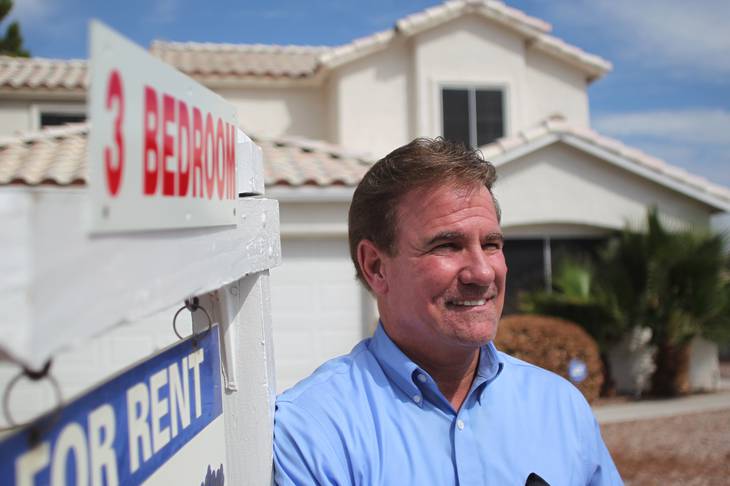During the fat, happy years of Las Vegas real estate, almost anyone could become a real estate agent and do well — strippers, blackjack dealers, busboys, you name it. Deals were so plentiful and easy to land, little expertise was required.
Not anymore.
Nowadays, it takes skill, hustle and a willingness to adapt to a changing, volatile industry to make it as a real estate agent.
Years after the local property market crashed and Las Vegas’ economy imploded, the real estate business is much smaller and more competitive than it was during the boom years. Outsiders who jumped in during the frenzy have left town, while the agents who remain jostle for a limited supply of deals.
Total real estate licenses
The number of people licensed as real estate agents or brokers in Nevada peaked in 2007:
2003: 22,141
2004: 25,626
2005: 31,280
2006: 34,946
2007: 35,800
2008: 33,423
2009: 29,204
2010: 27,189
2011: 24,895
2012: 23,401
2013: 23,056
Source: Nevada Real Estate Division
Although home prices are beginning to soar again, inventory is relatively tight, making it tough to get listings, and with multiple buyers vying for each home, agents can find it hard to close a deal with dozens of competing offers for each property.
Meanwhile, commercial vacancy rates slowly are improving but remain bloated compared with a decade ago. Back then, brokers simply had to wait by the phone to get new clients. Today, they have to be aggressive to beat their competition.
As a result, agents have overhauled their business to stay afloat. They now make cold calls, network and chase leads – hustling that practically evaporated during the boom era. They also work with banks and mortgage companies to sell foreclosed properties, deals they passed on a decade ago.
“This is a brand new business with brand new players,” said longtime commercial real estate broker Kit Graski, an executive vice president with Voit Real Estate Services.
In 2003, near the start of the construction boom, 22,141 people were licensed in Nevada as real estate brokers or agents. The number of licensees soared 62 percent to 35,800 by 2007 but dropped to 23,056 this year, according to Nevada Real Estate Division Administrator Gail Anderson.
Similarly, the Greater Las Vegas Association of Realtors, a trade group for housing agents and brokers, had 9,400 members in 2003. Membership peaked at almost 17,500 in 2007 but fell to roughly 11,300 this year.
A good number of agents moved out of Las Vegas when business dried up, while others returned to previous careers.
During the boom years, housing subdivisions popped up like weeds, banks gave mortgages to practically anyone, and people from all walks of life with no real estate experience jumped into the industry to make a quick buck. It took almost no work. Agents just had to drive clients to the nearest housing development and let the buyers pick what they wanted, RE/MAX Extreme agent Tim Kelly Kiernan said.
After the market crashed though, construction dried up, and agents who didn’t switch careers or leave Las Vegas scrambled for business. The valley become ground zero for foreclosures and underwater borrowers.
Agents began focusing on distressed housing.
Selling bank-owned homes kept Kiernan afloat during the recession. Today, 90 percent of his business involves short sales, a grinding process that can take a year or more.
“I go where the need is, and right now, the need is short sales,” he said.
Other agents have resurrected sales tactics that many of them abandoned during the boom years. They are holding more open houses, joining real estate associations with increasing frequency and saturating neighborhoods with postcards, newsletters and other marketing material to try to establish themselves as a local housing expert.
Overall, listings are plentiful but not as abundant as in years past. That’s thanks in large part to cash buyers. Investors have swooped into the valley to snap up cheap homes in bulk to turn into rentals.
About 14,000 single-family houses were available on GLVAR’s listing service at the end of July, up 3 percent from June but down 17 percent from a year earlier. In July 2007, 24,000 houses were listed.
Robyn Yates knows all too well how volatile the market can be. She launched Windermere Real Estate in January 2004 with 14 affiliate agents. By 2007, the company had grown to include 250 agents. Now, there are 125.
This year, however, has been Windermere’s best, Yates said. Home prices, after plunging when the market crashed, have climbed more than 30 percent over the past year, allowing agents to bring in larger commissions. As a broker, Yates takes a cut of the proceeds.
Windermere also has been helped by the rebounding luxury home sector.
The commercial real estate market, on the other hand, hasn’t rebounded quite as strongly. The commercial sector never received the same influx of brokers as the housing sector, but business has changed just as much since the boom.
Like residential real estate, selling and renting commercial properties was an easy job during the flush years. Office buildings, shopping centers and warehouses were being built all over the valley, and there was no shortage of people willing to quickly buy or lease them. There were so many deals going on that brokers merely had to wait around for business to roll in.
“As long as you were near a phone, you had the ability to make money,” said industrial broker Dan Doherty, a senior vice president at Colliers International.
Doherty had his best year ever in 2009 thanks to a $26 million sale of a six-building, 200,000-square-foot industrial project off Rainbow Boulevard and Sunset Road.
The following year, however, business dried up, for him and many other brokers. Doherty’s income plunged 85 percent. He sold everything he could live without – his 28-foot deck boat, 20-foot bass boat and souped-up Chevy pickup.
Business has improved over the past few years, Doherty said, but there remains heightened competition for deals.
To give himself a leg up, Doherty offers potential clients free advisory work. He also spends more time pitching people on the phone and in person.
“It’s a lot of the stuff that we stopped doing when business got so good,” he said.
Dan Palmeri never knew the good times. He became an office broker just as the market crashed and industry veterans began losing gobs of money.
“I definitely saw the fear in their eyes,” said Palmeri, a director with Cushman & Wakefield Commerce Real Estate Solutions.
Southern Nevada’s office vacancy rate fell as low as 7.9 percent in 2006 but has hovered above 20 percent since spring 2009, according to Colliers.
Palmeri specializes in finding office space for tenants, rather than leasing space for landlords, and finds clients through networking and referrals.
Business is picking up for him, too. This year, he placed SolarCity Corp., a solar panel installation firm, in Town Square.
And though he joined the industry at a horrible time, Palmeri is hooked on real estate. He said he likes to drive around town and see the logos of companies he represented on buildings. He also enjoys the suit-and-tie culture of an office brokerage.
Palmeri used to work at his family’s restaurant, Gaetano’s Ristorante, in Henderson. He started selling houses in the mid-2000s, then switched to multifamily units and eventually office buildings.
He knows he entered an industry prone to booms and busts.
“It’s all cyclical,” he said. “Eventually, (a crash) will end up happening again.”
But Palmeri is willing to ride out the waves.
“I plan on doing this until I retire,” he said. “I already got through it once. Why not do it again?”

